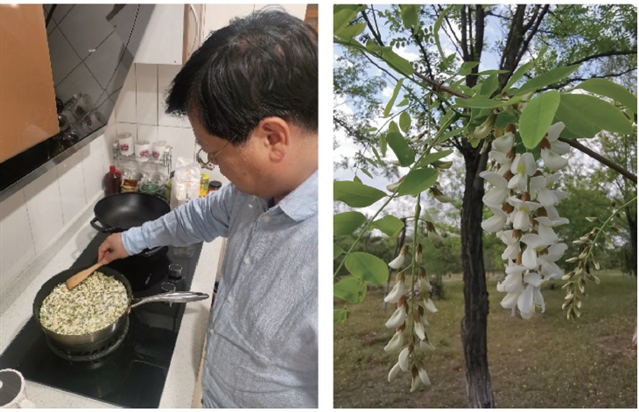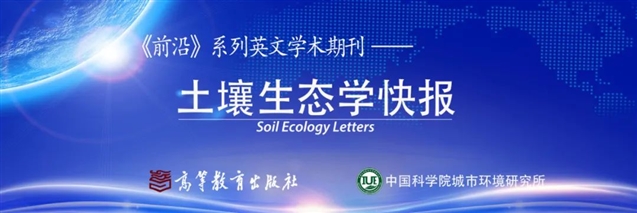|
|
|
|
|
SEL | 前沿睿见:蔬食——“烹饪”可持续的未来 |
|
|
论文标题:Plant-based diet: “Cook up” the sustainable future(蔬食——“烹饪”可持续的未来)
期刊:Soil Ecology Letters
作者:Yong-Guan Zhu
发表时间:17 Jun 2022
DOI:10.1007/s42832-022-0150-6
微信链接:点击此处阅读微信文章
Soil Ecology Letters秉承“百家争鸣”的宗旨,致力于成为土壤生态学领域的学术交流平台。推出新栏目ESSAY,以短而精的文笔,评述或说明事实,进而提出观点。本文朱永官院士提出以植物为基础饮食,既健康又减少环境影响。
ESSAY
Plant-based diet: “Cook up” the sustainable future
Yong-Guan Zhu
Soil Ecology Letters,
https://doi.org/10.1007/s42832-022-0150-6
原文链接,点击文末“阅读原文”获取
Last spring, while seeking opportunities of developing value-added organic fertilizers for sustainable crop production, I visited a very large chicken farm in Fujian province, east China. After careful disinfection and wearing a protective coat, I entered one of the chicken hubs. I saw thousands of chicks living in high density but under well controlled growth conditions. Afterwards, when I went to the processing section of the farm, I was thrilled by the highly automated facilities, from slaughtering, plucking, dissecting, and freezing to packing. With these intensive and automatic facilities, each year this farm produces nearly 600 million chickens, something like one chicken for every two Chinese people.
Thanks to these highly intensive animal farms we can have meat pretty much whenever we like to eat meat. As a result, many people take animal food for granted without actually realizing what is behind the meat we consume, such as feed, manure, antibiotics and greenhouse gas emissions.
Research has already shown that on average we are eating too much meat, much more than we need. And overeating meat is not only unhealthy, it also greatly increases the ecological footprint of our life, causing negative effects on our living environment and the entire planet.
Some 40 years ago, when I was a kid (seems a long time ago, though I still feel I am rather young!), meat was in short supply. Each family had a quota and a voucher was used to purchase meat. In those days, my parents struggled to feed their three boys with reasonably nutritious meals, often with rice and “stir-fry” dishes largely composed of mixtures of diverse plants.
Although nearly half a century has passed, my taste buds still live in my childhood, and I am tightly bound to the dishes that my parents cooked. It is the taste of home that has been lingering in my mind. Thus, over the years, I have been enjoying cooking food for my family and friends, partly to satisfy my youthful taste buds (Fig.1).

Fig. 1 In the spring, wild plants are harvested for food, and the flower of Sephora Japonica Linn is a popular food in northern China, for making flower pan cake.
“Stir-fry” dishes usually contain only around 10 % meat or no meat at all, and the meat is cut into small cubes, slices or shreds. The meat, according to personal preference and nutritional value, can be stir-fried with very diverse vegetables. Beyond personal preference and nutrition, the choice of vegetables can also be made for the texture or visual impact. For example, you can stir-fry slices of carrot, yam, snow pea and meat (or sometimes with black fungi-“tree ear”, a very nice combination of colors, therefore giving the additional joy of the visual pleasure of the meal. You can also cook shreds of bamboo shoot (crunchy), solid bean curd (soft) and meat (chewy), that gives you a mixture of different textures, thus increasing the pleasure of chewing. I thus think “stir-fry” dishes with diverse vegetables and optimum meat (and its flavour) gives you balanced nutrition, but represents a much-reduced impact on the environment.
The other cooking technique that I like a lot is “stuffing”. Instead of having pure meat balls, I often stuff pork mince into puffed bean curd (thus containing lot of small pores inside it). By stuffing, the meat portion makes very close contact with the puffed bean curd. After stewing, meat flavour and fat are gradually released and penetrate the pores. This actually allows the full integration of the meat and bean curd, and when you bite it the meaty fragrance will burst into your mouth, and then while chewing you will enjoy the pleasure of combined flavours and textures. Cooking in this way reduces meat intake by at least 50% and delivers more balanced nutrition, and enhanced pleasure of the meal!
Another sustainable dish in China is soup, with a wide range of soups, often with lots of vegetable ingredients and meat or animal bones (chicken, pork or fish). Soups are usually served at the beginning of the meal, particularly in southern China, such as Hong Kong and Canton. One soup that I still remember vividly is a soup combining soybean and pig bones. In the old days, one could buy pig bones without a voucher by going to the butcher’s shop early in the morning. Soybean/bone soup not only satisfies your nutritional needs and sensory pleasure, but is also very economical! After the meal you can sun-dry the bones and sell them through a waste recovery system, and you can possibly recover the cost of buying them in the first place! Animal bones can be used to make bone meals for feed (rich in phosphorus and calcium) and bone char is a high-quality adsorbent and soil amendment. Nowadays, unfortunately, much of the food waste is disposed of in landfill or incinerated. What a waste!
China is also famous for making full use of animal products, from feet, tripe, intestines to blood. Animal fat is usually well used, in some cases the fat is rendered with dry heat to make lard. A simple plant-based meal could be just rice with lard, this was a typical childhood meal for my family. While the freshly cooked rice is still warm, you take a teaspoon of lard and mix it with the rice. The lard will melt away and through mixing each rice grain will eventually be coated with the flavorful oil, then you dress the rice with soy sauce. You can imagine what sensory pleasure you can get with the blending of fat fragrance and soy sauce umami. On the side with the rice, you can also have a small dish of pickled vegetables and fried peanuts. The remaining material after rendering by lard-crackling can be used in “stir-fry” dishes, for example Chinese leaves or any other green vegetables, or simply as a fragrant crispy snack.
My collaborator, Professor Qirong Shen from Nanjing, once commented that he is not too impressed with all the papers I have published (although there must be some good ones), but he is astounded by the delicious food that I can cook. Well, actually this comment is a bit of an exaggeration. After all, we all have to eat, and being able to cook is both natural and basic. But I do think that developing plant-based cuisine has an important and lasting impact on both personal health and the Earth’s sustainability.
Acknowledgements
I thank Dr Peter Christie, my first supervisor overseas, and his wife Susan for their comments. They both are practicing sustainable lifestyle, and in particular they take plant-based diet.
SEL 综述文章推荐
Soil inorganic carbon sequestration through alkalinity regeneration using biologically induced weathering of rock powder and biochar
Muhammad Azeem, Sajjad Raza, Gang Li, Pete Smith,
Yong-Guan Zhu
2022, https://doi.org/10.1007/s42832-022-0136-4
Responses of soil microbial carbon use efficiency to warming: Review and prospects
Qiufang Zhang, Wenkuan Qin, Jiguang Feng, Biao Zhu
2022, https://doi.org/10.1007/s42832-022-0137-3
Microfluidic hotspots in bacteria research: A review of soil and related advances
Hengyi Dai, Yajuan Zhuang, Erinne Stirling, Nanlin Liu, Bin Ma
2022, https://doi.org/10.1007/s42832-022-0129-3
Perspectives on ecological risks of microplastics and phthalate acid esters in crop production systems
Fang Wang, Yu Wang, Leilei Xiang, Marc Redmile-Gordon, Chenggang Gu, Xinglun Yang, Xin Jiang, Damià Barceló
2022, 4: 97-108. https://doi.org/10.1007/s42832-021-0092-4
Zooming in to acquire micro-reaction: Application of microfluidics on soil microbiome
Xiongkun Zhang, Shan Wu, Xiaojie Sun, Monika Mortimer, Yichao Wu, Ming Zhang, Qiaoyun Huang, Peng Cai
2022, 4: 213-223. https://doi.org/10.1007/s42832-021-0073-7
Compatible package-based agriculture systems: an urgent need for agro-ecological balanceand climate change adaptation
Rishikesh Singh, Tanu Kumari, Pramit Verma, Bhupinder Pal Singh, Akhilesh Singh Raghubanshi
2022, 4: 187-212. https://doi.org/10.1007/s42832-021-0087-1
The roles and performance of arbuscular mycorrhizal fungi in intercropping systems
Minghui Li, Junli Hu, Xiangui Lin
2021, https://doi.org/10.1007/s42832-021-0107-1
Lessons learned from COVID-19 on potentially pathogenic soil microorganisms
Haifeng Qian, Qi Zhang, Tao Lu, W.J.G.M. Peijnenburg, Josep Penuelas, Yong-Guan Zhu
2021, 3: 1-5. https://doi.org/10.1007/s42832-020-0068-9
Revisiting mycorrhizal dogmas: Are mycorrhizas really functioning as they are widely believed to do?
Felipe E. Albornoz, Kingsley W. Dixon, Hans Lambers
2021, 3: 73-82. https://doi.org/10.1007/s42832-020-0070-2
Evaluation methods of heavy metal pollution in soils based on enzyme activities: A review
Yongxing Cui, Xia Wang, Xiangxiang Wang, Xingchang Zhang, Linchuan Fang
2021, 3: 169-177. https://doi.org/10.1007/s42832-021-0096-0
征 稿!
Soil Ecology Letters致力于成为土壤生态学领域的学术交流平台,稿件类型风格不限,不拘一格,欢迎短而精的投稿,1)可以是一张重要研究成果图片,附带简要介绍说明文字;2)可以是对突破性进展的解读、评述;3)可以是学术质疑、学术思想的碰撞;4)也可以是对老一辈研究者的缅怀;5)亦可以是自身的成长故事……
直接与编辑部联系投稿SEL@pub.hep.cn,优秀稿件走绿色通道
期刊简介
Soil Ecology Letters(SEL) 由高等教育出版社与中国科学院城市环境研究所共同主办,SpringerNature海外发行。报道领域包括:土壤生物多样性、土壤互营和食物网、土壤微生物组、土壤—植物相互作用、土壤生物地球化学循环、土壤生物修复和恢复、土壤多功能性、土壤生物对环境变化的响应和适应、土壤生态过程的突破性技术、新理论和模型。栏目包括但不限于:letter to editor, perspective, review, rapid report, research article, commentary, SEL digest。
出版模式
快速出版:加速审稿,以CAP模式快速发表。
出版费用:免一切费用,包括审稿费、彩图费、出版印刷费等。
全文国内免费获取。
收 录
ESCI, SCOPUS, CSCD, BIOSIS, Geobase, Biological Abstracts, Google Scholar等。
绿色通道
SEL优先快速发表高质量论文。如需快速抢发的优秀论文,可直接与编辑部联系SEL@pub.hep.cn,主编将亲自处理,文章投稿后两周内上线。
联系方式
期刊主页:
http://journal.hep.com.cn/sel
https://link.springer.com/journal/42832
投稿网址:
https://mc.manuscriptcentral.com/selett
编辑部:
电话:010-58556534
邮箱:SEL@pub.hep.cn
“土壤生态学”系列学术讲座
“土壤生态学”系列学术讲座依托Soil Ecology Letters期刊与新媒体平台,致力于传播与分享土壤生态学前沿进展,促进土壤生态学科研工作者的交流。

《前沿》系列英文学术期刊
由教育部主管、高等教育出版社主办的《前沿》(Frontiers)系列英文学术期刊,于2006年正式创刊,以网络版和印刷版向全球发行。系列期刊包括基础科学、生命科学、工程技术和人文社会科学四个主题,是我国覆盖学科最广泛的英文学术期刊群,其中13种被SCI收录,其他也被A&HCI、Ei、MEDLINE或相应学科国际权威检索系统收录,具有一定的国际学术影响力。系列期刊采用在线优先出版方式,保证文章以最快速度发表。
中国学术前沿期刊网
http://journal.hep.com.cn

特别声明:本文转载仅仅是出于传播信息的需要,并不意味着代表本网站观点或证实其内容的真实性;如其他媒体、网站或个人从本网站转载使用,须保留本网站注明的“来源”,并自负版权等法律责任;作者如果不希望被转载或者联系转载稿费等事宜,请与我们接洽。